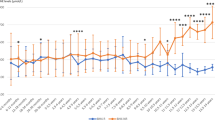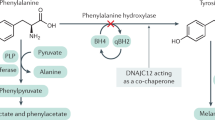Abstract
A 1890-g newborn on total parenteral nutrition (TPN) had phenylalanine levels reaching 4164 μM indicating phenylketonuria (PKU). Review of 64 PKU cases from the California Newborn Screening Program disclosed another newborn diagnosed while on TPN. Phenylalanine levels rose five times faster with TPN, as estimated from rates in these infants. Thus, TPN use is associated with very high phenylalanine levels in newborns with PKU. When starting TPN soon after birth (for example, on day 1), early detection of PKU—by newborn screening 12 to 24 h after infusions are begun—should be helpful in limiting exposures to toxic levels of phenylalanine.
This is a preview of subscription content, access via your institution
Access options
Subscribe to this journal
Receive 12 print issues and online access
$259.00 per year
only $21.58 per issue
Buy this article
- Purchase on Springer Link
- Instant access to full article PDF
Prices may be subject to local taxes which are calculated during checkout

Similar content being viewed by others
References
Heird WC, Hay W, Helms RA, Storm MC, Kashyap S, Dell RB . Pediatric parenteral amino acid mixture in low birth weight infants. Pediatrics 1988; 81: 41–50.
Winters RW . Total parenteral nutrition in pediatrics: the Borden award address. Pediatrics 1975; 56: 17–23.
Kemmerer KS . Amino acids product and method of manufacture. US Patent 2 180 637; 1939.
Shohl AT, Butler AM, Blackfan KD, MacLachlan E . Nitrogen metabolism during the oral and parenteral administration of the amino acids of hydrolyzed casein. J Pediatr 1939; 15: 469–475.
Helfrick FW, Abelson NM . Intravenous feeding of a complete diet in a child: report of a case. J Pediatr 1944; 25: 400–403.
Wilmore DW, Dudrick SJ . Growth and development of an infant receiving all nutrients exclusively by vein. JAMA 1968; 203: 860–864.
Ghadimi H . Injectable amino acid composition commensurate to the anabolic need of the body and method of using same. US Patent 3 832 465; 1974.
Dell RB, Winters RW, Heird WC . Amino acid solutions for parenteral nutrition and methods of formulation and use. US Patent 4 491 589; 1985.
Heird WC, Driscoll Jr JM, Schullinger JN, Grebin B, Winters RW . Intravenous alimentation in pediatric patients. J Pediatr 1972; 80: 351–372.
Winters RW, Heird WC, Dell RB . History of parenteral nutrition in pediatrics with emphasis on amino acids. Fed Proc 1984; 43: 1407–1411.
Vlaardingerbroek H, van Goudoever JB, van den Akker CH . Initial nutritional management of the preterm infant. Early Hum Dev 2009; 85: 691–695.
Saini J, MacMahon P, Morgan JB, Kovar IZ . Early parenteral feeding of amino acids. Arch Dis Child 1989; 64: 1362–1366.
Denne SC, Poindexter BB . Evidence supporting early nutritional support with parenteral amino acid infusion. Semin Perinatol 2007; 31: 56–60.
Radmacher PG, Lewis SL, Adamkin DH . Early amino acids and the metabolic response of ELBW infants (⩽1000 g) in three time periods. J Perinatol 2009; 29: 433–437.
Valentine CJ, Fernandez S, Rogers LK, Gulati P, Hayes J, Lore P et al. Early amino-acid administration improves preterm infant weight. J Perinatol 2009; 29: 428–432.
Uhing MR, Das UG . Optimizing growth in the preterm infant. Clin Perinatol 2009; 36: 165–176.
Neu J . Is it time to stop starving premature infants? J Perinatol 2009; 29: 399–400.
Waisbren SE, Noel K, Fahrbach K, Cella C, Frame D, Dorenbaum A et al. Phenylalanine blood levels and clinical outcomes in phenylketonuria: a systematic literature review and meta-analysis. Mol Genet Metab 2007; 92: 63–70.
Chan K, Ohlsson A, Synnes A, Lee DS, Chien LY, Lee SK . Survival, morbidity, and resource use of infants of 25 weeks’ gestational age or less. Am J Obstet Gynecol 2001; 185: 220–226.
Levy HL, Waisbren SE, Güttler F, Hanley WB, Matalon R, Rouse B et al. Pregnancy experiences in the woman with mild hyperphenylalaninemia. Pediatrics 2003; 112: 1548–1552.
Acknowledgements
JMC was supported by grant 1U50DD000475-02 from the US Centers for Disease Control.
Author information
Authors and Affiliations
Corresponding author
Ethics declarations
Competing interests
The authors declare no conflict of interest.
Rights and permissions
About this article
Cite this article
Lin, H., Kwong, A., Carter, J. et al. Extremely high phenylalanine levels in a newborn on parenteral nutrition: phenylketonuria in the neonatal intensive care unit. J Perinatol 31, 507–510 (2011). https://doi.org/10.1038/jp.2010.207
Received:
Revised:
Accepted:
Published:
Issue Date:
DOI: https://doi.org/10.1038/jp.2010.207
Keywords
This article is cited by
-
Newborn metabolic vulnerability profile identifies preterm infants at risk for mortality and morbidity
Pediatric Research (2021)
-
The complete European guidelines on phenylketonuria: diagnosis and treatment
Orphanet Journal of Rare Diseases (2017)



